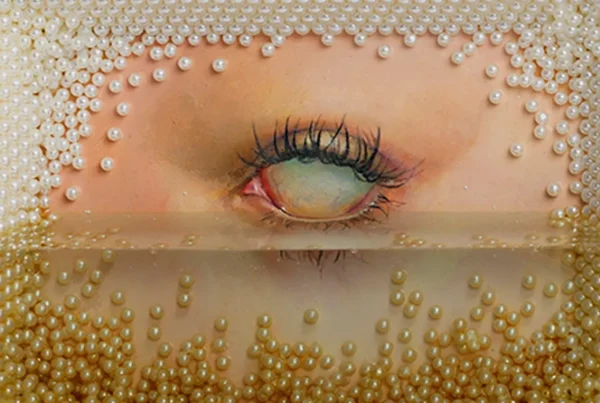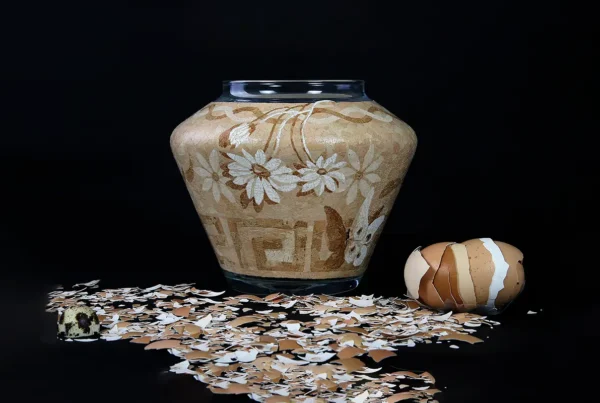Microscopic Inspiration: Crafting the Biology of Form
The intersection between science and art is rarely navigated with the kind of clarity and originality that defines Abid Javed’s sculptural practice. Based in London, Javed brings a uniquely dual perspective to the art world, one that draws equally from his academic training in molecular biology and his passion for ceramic artistry. His work bridges the gap between scientific inquiry and visual storytelling, turning the invisible inner structures of life into tangible, poetic forms. Instead of replicating what he sees under a microscope, Javed reimagines cellular structures and molecular architectures as fluid, sculptural expressions of form, balance, and movement. The result is a body of work that not only reflects deep intellectual inquiry but also invites emotional and sensory engagement.
Born in Hong Kong and shaped by a multicultural heritage, Javed’s early life was marked by a fascination with both science and the built environment. Although he initially considered a career in architecture, his analytical mindset eventually led him to pursue a PhD in molecular biology. While conducting microscopic research on proteins and DNA, a latent desire began to take root — to transform scientific data into physical objects that could embody the elegance and complexity of what he observed. A recommendation to take a local pottery class marked a turning point, setting him on an entirely new path. Within a year and a half, he had immersed himself in the material world of clay, driven by the same curiosity and discipline that shaped his research career.
What distinguishes Javed’s work is its ability to occupy a space between sculpture and design without compromising the integrity of either. His collectible pieces, often described as “molecular objects,” are built entirely by hand using traditional ceramic techniques such as pinching, coiling, and slab construction. The artist’s precise attention to surface texture, muted tones, and formal harmony reflects both scientific order and artistic instinct. Each object emerges as a contemplation on the structure of life, not as it appears under a microscope, but as it might be felt and imagined — abstract, fluid, and deeply interconnected.

Abid Javed: A Molecular Language of Clay and Culture
Javed’s approach is not solely grounded in biology. His aesthetic sensibilities are equally shaped by his Pakistani heritage and a long-standing admiration for Islamic art and geometry. These influences filter into his work through compositional balance, pattern references, and the subtle repetition of forms that evoke the rhythm of Arabic script or the symmetry of architectural ornamentation. For Javed, the fusion of science and cultural memory becomes a conceptual lens through which form is not just seen but experienced. He often asks himself how the micro can echo the macro, how cells and sacred patterns might converse across disciplines and time.
This sense of cultural and scientific hybridity is especially visible in his series Pleomorphs, developed during the global pandemic. Drawing from the biological term “pleomorphism,” which refers to the capacity of organisms to change shape, Javed used this concept as a metaphor for emotional and societal adaptability. The collection explores forms that seem to morph, stretch, and recombine — embodying both biological resilience and the human condition during times of disruption. These ceramic sculptures do not imitate living organisms but rather evoke the sensation of life in flux, capturing moments of tension, release, and growth in three-dimensional space.
With each piece, Javed strives to make invisible systems palpable. He likens clay to a language — one that can express both the organic unity of biological structures and the abstract poetics of cultural identity. His restrained color palette, typically ranging from soft whites to deep browns and blacks, allows form and texture to take center stage. Whether a vessel, lamp, or modular sculpture, each object reflects a careful balancing act between spontaneity and control. It is in this balance that his unique voice as an artist emerges: deeply personal, rigorously thoughtful, and quietly profound.

Designing Light, Sculpting Function
Javed’s work extends beyond the sculptural into a design language that continues to evolve. His studio extension, Objets Mito, marks a decisive shift toward functional forms that retain sculptural integrity. Inspired by mitochondrial structures — essential energy sources within cells — this collection of lighting objects, including candelabras, candle holders, and lamps, reveals a fascination with how light can become part of a sculptural narrative. The name itself echoes both biological origins and a mythic reinterpretation of design, framing utility as an expressive gesture. For Javed, lighting is not merely about illumination; it is about creating spatial presence and emotional resonance.
His lamps often feature planar paper shades that produce diffuse, directional lighting, drawing clear influence from Isamu Noguchi’s Akari series. Paper, a material he was intuitively drawn to, provides an organic counterpoint to ceramics, especially when used to filter and soften light. In these works, Javed explores how material transparency, fragility, and form can coalesce into a unified object that quietly transforms its surroundings. His use of beeswax further demonstrates a fascination with overlooked materials. By molding beeswax into vessels and ikebana-inspired forms, he explores texture, translucency, and fluidity in ways that challenge conventional notions of what sculptural material can be.
Recent developments in his practice include the introduction of a sculptural chair crafted in modular ceramic components, another piece from Objets Mito. Inspired by mitochondrial DNA, the chair’s segmented construction mirrors the internal complexity of the human body, while its organic contours push the boundaries of what ceramics can structurally achieve. Each limitation, such as the constraints of his kiln, becomes a creative problem to solve — prompting designs that are not only modular but conceptually resonant. The chair’s form becomes a symbolic anatomy of life: the legs, representing genetic scaffolds; the seat and back, translating protein chains into functional design.

Abid Javed: Nature’s Seamless Lessons
At the heart of Javed’s creative process lies a deep attentiveness to the subtle patterns of the everyday natural world. His fascination with the seamlessness of nature — the quiet continuity between forms, movements, and functions — serves as both inspiration and challenge. Observing molecular interactions under the microscope or simply noting how organic forms unfold in daily life, Javed translates these fleeting harmonies into works that feel as if they have grown into themselves. He often reflects on how to make his objects seem effortlessly connected, capturing a sense of being rather than constructing.
This commitment to seamlessness is not aesthetic alone; it reflects a deeper philosophical engagement with how parts relate to wholes. Whether working with paper, wax, glass, or clay, Javed strives for integration, both materially and conceptually. His recent interest in glass stems from a long-standing desire to explore its sculptural capabilities. Drawn to its transformative nature and its elemental kinship with ceramics, Javed is currently investigating how these two materials might intersect in future works. For him, it is not about combining mediums for novelty, but about exploring continuity — how light passes through surfaces, how opacity and translucence interact, and how one material can suggest the qualities of another.
His scientific training, often viewed as an unlikely background for an artist, instead provides a vital foundation for the way he thinks and works. The processes of research, experimentation, and critical inquiry are deeply embedded in his methodology. He approaches each new project with curiosity, intent on understanding how ideas mutate and grow. In this sense, Javed’s practice is not static; it is in constant transformation, echoing the biological principles that first drew him to clay. Just as molecules evolve and adapt, so too does his art — always searching, always becoming.






